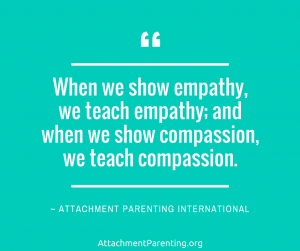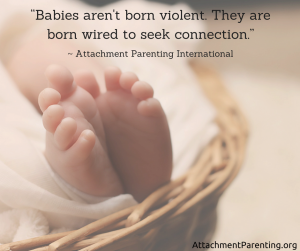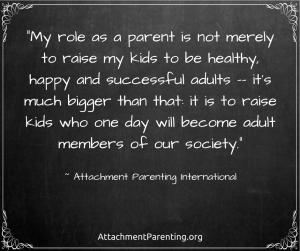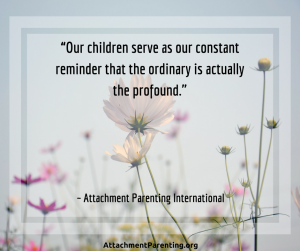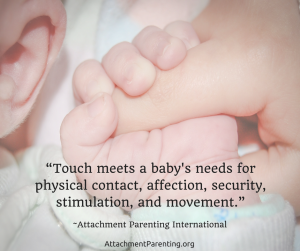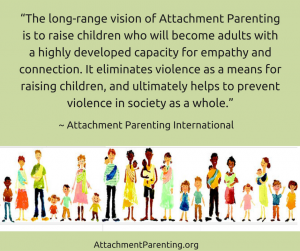Category: APtly Said
Babies are born to connect
My role as a parent
The ordinary is profound
Attached Family: Parenting without shame
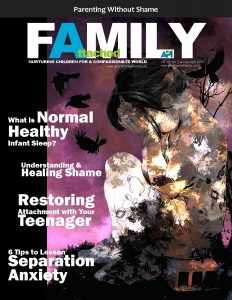 Attachment Parenting International (API) is pleased to announce the release of the latest issue of Attached Family: “Parenting Without Shame.”
Attachment Parenting International (API) is pleased to announce the release of the latest issue of Attached Family: “Parenting Without Shame.”
In this issue of Attached Family, API examines shame versus guilt and how shame contributes to emotional trauma. API looks at the intersection of parenting and shame, keeping in mind that shame is a normal emotional response to certain social situations, but like anger or disappointment, when unresolved, shame can lead to lifelong difficulties.
Inside this issue, you’ll find mind-bending, inspiring, and empowering features to stretch your parenting wings:
- “What is Shame?” by API Executive Editor Rita Brhel — defines shame, how it differs from guilt, when it crosses the line to become toxic shame, and what parents need to know
- “Core Beliefs Color Your Parenting,” also by Rita Brhel — explains how shame-based core beliefs affect our everyday decisions, including our parenting behaviors
- “What Makes Emotional Trauma? Fear, Disconnect and Shame,” an interview with Daniela Sieff, PhD — explores the ingredients to developing a shame-based view of oneself and what is all involved in healing, which certainly underlines the importance of prevention through parenting
- “Parenting as a Protest Against Hate” by Lauren Gottschalk-Scher, motherhood fashion designer — looks at how parenting can be activism
- “What is Normal, Healthy Infant Sleep?” by API KnowledgeBase Coordinator Art Yuen — discusses what biologically normal sleep in infants, and adults, looks like and the effects that artificial light and work productivity expectations have
- “6 Tips to Lessen Separation Anxiety,” also by Art Yuen — looks at goodbye routines and other ideas for children and their parents when separation is necessary, such as for working parents
- “Self-Validation Before Self-Control” by Denise Durkin, MA, child mental health consultant — explains how development of a positive self-worth must be in place first before trying to teach a child self-control
- “Engagement vs Redirection to Create Emotional Safety,” also by Denise Durkin — describes the differences between these two discipline techniques and why engagement may be the better choice
- “11 Ways to Parent Outside the Box” by Brooke Campbell, MA, creative therapist — gives ideas on how to incorporate more attunement in parenting
- “How to Heal Attachment with Your Teen” by Shoshana Hayman, Neufeld Institute Faculty — outlines how the teenage years can reveal attachment weaknesses and how to restore a close attachment when necessary.
Shame can be a difficult topic for parents. This issue of Attached Family helps you be able to explore this topic safely. API hopes you take away the idea that parents don’t need to fear shame as a normal emotion, but rather that when shame enters our children’s lives, that Attachment Parenting is exactly how to address it in a healthy way.
Touch
4 tips for cultivating a “yes environment”
 Children hear the word “no” about 400 times a day. Being told “no” constantly doesn’t feel good and often times can be frustrating. The more children hear it, the more likely they are to have tantrums and power struggles, and feel disconnected from their parents.
Children hear the word “no” about 400 times a day. Being told “no” constantly doesn’t feel good and often times can be frustrating. The more children hear it, the more likely they are to have tantrums and power struggles, and feel disconnected from their parents.
Creating a “yes environment” can help families to feel happier and more connected.
This doesn’t mean you must say “yes” to literally everything, or that the word “no” should be nonexistent. It’s important to keep boundaries and to set the limits that are right for your family. The point of creating a “yes environment” is to save the “no” for the occasional vital situations — safety reasons, things that go against family rules, or times when something truly isn’t possible to do.
Here are 4 tips for cultivating a “yes environment”:
- Make sure your “no” is really a no — Sometimes we say “no” to a request before we even really think about it. It’s important to take the time to think before answering children’s requests. For example, Is it really unsafe when my sons are roughhousing? Can I make it safer by removing obstacles from the room and helping them set some ground rules? Or, Do I have the time to do this art project? Am I inclined to say “no” just because I don’t want to deal with the potential mess? There are many times when my children will ask to go the playground, but I simply don’t feel like it and I want to start thinking of every excuse not to go. However, when I try to stay in “yes” mode and give it a try, so often I have more fun than expected. I end up feeling grateful that I chose to have that moment of connection with my children and to say “yes” to adventures and exploration.
- Save “no” for when it matters — When we say “no” all the time, the word loses some of its significance and effectiveness. “No” is a strong word. Our children need to know that it really matters. That’s important both in having them listen to and respect people who tell them “no,” as well as in situations where their own “no” needs to be respected by other people. When we save “no” for the situations that really matter, it makes the word more powerful — our children know that we indeed mean it.
 “Yes…later” — Sometimes your child will ask to do something that would be a “yes” at a different time, like wanting to go to the playground shortly before you need to pick up an older child from school. Instead of saying, “No, we can’t go now. We don’t have time,” you might say, “Yes, we can go to the park after we get your sister from school.” Reframing your words in a positive way, rather than using negative language, is helpful to children.
“Yes…later” — Sometimes your child will ask to do something that would be a “yes” at a different time, like wanting to go to the playground shortly before you need to pick up an older child from school. Instead of saying, “No, we can’t go now. We don’t have time,” you might say, “Yes, we can go to the park after we get your sister from school.” Reframing your words in a positive way, rather than using negative language, is helpful to children.- Explain the “no” — Imagine your toddler is pulling your hair. Your first inclination may be to say, “No!” After all, it hurts, you’re angry, and you want to make it clear that it’s not OK. A more positive way to handle it would be to remain calm and say instead, “That hurts Mommy,” as you move her hand away from your hair. You’re not using the word “no,” but you’re also not allowing the behavior. Explaining it to her in this way will help her understand why you’re stopping their behavior. It also helps develop empathy and gives young children exposure to more language than just “no.”

